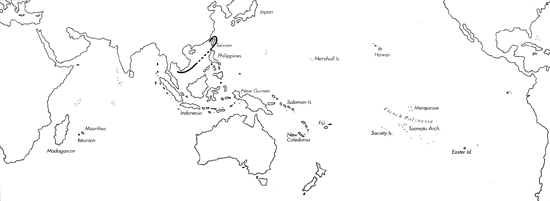
Skip Navigation Links
View access keys for this site.

Range: Taiwan and Vietnam.
Description: Moderately small to medium-sized, moderately light to moderately solid. Last whorl conical, outline almost straight. Shoulder angulate, undulate or weakly tuberculate. Spire of low to moderate height, outline concave. Larval shell of 2-2.25 whorls. maximum diameter about 0.8 mm. First 4-5 postnuclear whorls tuberculate, following whorls undulate. Teleoconch sutural ramps flat, with 1-2 increasing to 2-5 spiral grooves. with additional striae in last whorls. Last whorl with rather widely spaced spiral grooves on basal half, more narrowly spaced near base.
| Shell Morphometry | ||
|---|---|---|
| L | 30-42 mm | |
| RW | 0.08-0.12 g/mm | |
| RD | 0.50-0.63 | |
| PMD | 0.95-0.97 | |
| RSH | 0.08-0.24 | |
Ground colour white, occasionally suffused with pale violet. Entire last whorl with spiral rows of alternating yellowish brown or pink and white bars, squarish spots and dots; an orangish violet spiral band or a spiral row of yellowish brown to brown flecks may occur on each side of centre. Larval whorls white. Postnuclear sutural ramps with yellowish to orangish brown radial streaks that extend over outer margins. Aperture white
Habitat and Habits: Deeper subtidal zones.
Discussion: C. ciderryi is most similar to C. inscriptus and C. moluccensis. For the distinctions, see the Discussions of those species. Specimens from Vietnam (Pl. 34, Fig. 24) have a broader last whorl and a dark-coloured base.

C. ciderryi range map
This section contains verbatim reproductions of the accounts of 316 species of Conus from the Indo-Pacific region, from Manual of the Living Conidae, by Röckel, Korn and Kohn (1995). They are reproduced with the kind permission of the present publisher, Conchbooks.
All plates and figures referred to in the text are also in Röckel, Korn & Kohn, 1995. Manual of the Living Conidae Vol. 1: Indo-Pacific Region.
The range maps have been modified so that each species account has it own map, rather than one map that showed the ranges of several species in the original work. This was necessary because each species account is on a separate page on the website and not confined to the order of accounts in the book.
Return to framed version (returns to search page)